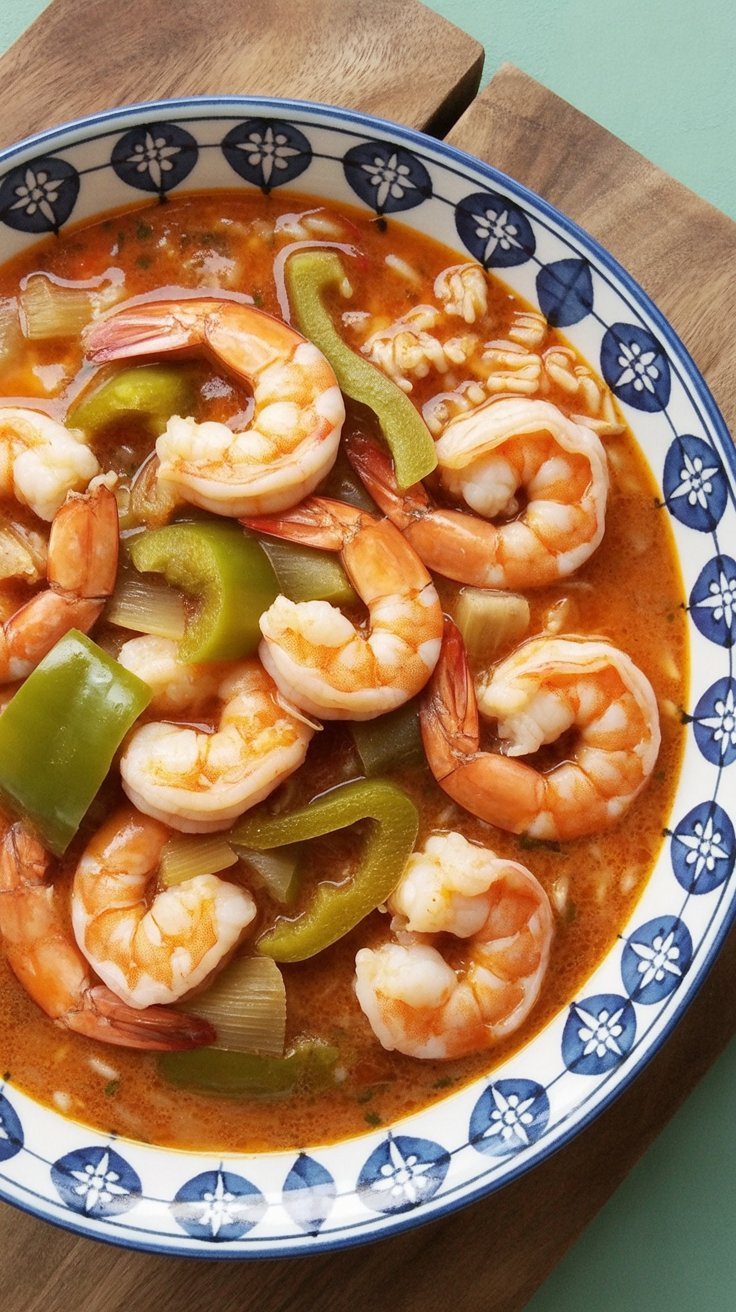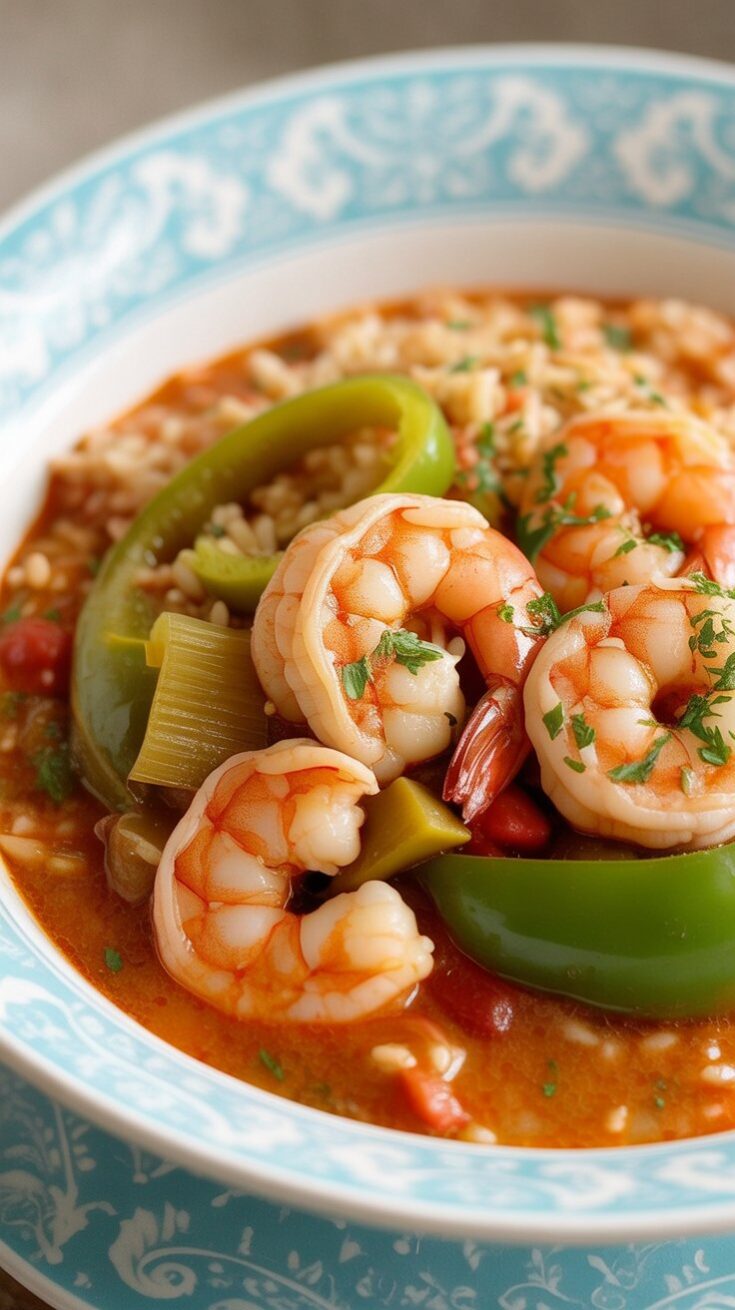If you’ve never had shrimp étouffée, just imagine the bold, soulful flavors of Louisiana cooking all smothered into one cozy, saucy dish. It’s one of those meals that hugs you from the inside out — rich roux, tender shrimp, and that unmistakable Cajun kick. It’s not just dinner. It’s a little trip down to the Gulf Coast.

My First Time Making Étouffée (and Why I’ve Been Hooked Since)
I remember the first time I tried shrimp étouffée — it was in a tiny kitchen in Kolkata, after I stumbled on a New Orleans food blog during a monsoon afternoon. I had no idea what I was doing, but the aroma that filled the room after I started my roux made me stop in my tracks. It smelled like something you’d slow dance with. That was the moment I fell hard for Cajun cooking.
Since then, I’ve made this dish a hundred different ways. This version is my favorite. It sticks to the spirit of the classic, with just the right amount of heat, a homemade shrimp stock, and that slow-cooked magic that only comes from taking your time.
What Makes Étouffée So Special?
In simple terms, étouffée means “smothered.” Think of it as gently simmering seafood in a deeply flavorful gravy made from roux, stock, and the classic Cajun vegetable base — onion, celery, and green bell pepper, lovingly known as the “Holy Trinity.”
Unlike gumbo, which often simmers all day and can include multiple proteins, étouffée is a little more delicate and focused. It’s all about the sauce and letting the shrimp shine.
Ingredients You’ll Need (and Why They Matter)
- Shrimp (preferably Gulf shrimp)
I always try to get the freshest shrimp I can find — shell-on if possible, so I can use those shells to build a deep, homemade stock. It’s the base that gives the sauce its backbone. - Roux (flour and oil)
This is where the magic begins. I cook mine until it turns the color of peanut butter — rich, nutty, and aromatic. It takes some patience, but it’s worth every minute. - Holy Trinity (onion, celery, bell pepper)
These three never let me down. Once they hit the roux, the kitchen smells like you’re cooking something truly special. - Garlic and Cajun seasoning
Add depth and that slow-building heat that makes each bite feel like a flavor crescendo. - Hot sauce (like Tabasco)
Just a few dashes, but don’t skip it — it brightens the dish and gives it that unmistakable Louisiana edge. - Shrimp stock
If you have the time, make it from the shells. It’s not difficult, and it transforms the whole dish. But in a pinch, a good-quality seafood or chicken stock works too.

How I Build the Flavor (Step-by-Step)
-
Start with the stock
If you’re using shrimp shells, simmer them with some onion, garlic, bay leaves, and a few peppercorns while you prep everything else. You’ll get a pot of liquid gold in about 30–45 minutes. -
Make the roux
In a heavy-bottomed pan, stir equal parts flour and oil over medium heat. Don’t rush it. Keep stirring until it turns a warm, toasty brown. This is the base of all the flavor. -
Add the Holy Trinity
Toss in chopped onion, celery, and green bell pepper. Let them soften and soak up that beautiful roux. Add garlic last so it doesn’t burn. -
Season and pour in the stock
Stir in your Cajun spices and hot sauce, then slowly add the shrimp stock while whisking. Let it simmer until it thickens into a silky, rich gravy. -
Finish with the shrimp
Add the peeled shrimp and simmer just until they’re pink and cooked through — about 3–4 minutes. Don’t overcook them or they’ll turn rubbery. -
Taste and tweak
This is where you adjust the salt, spice, and tang. Sometimes I add a splash more hot sauce or a pinch of cayenne depending on who’s coming for dinner.
Real-Life Tips from My Kitchen
- Make your roux calm and steady
Stir constantly, and use a wooden spoon or silicone spatula. It can burn quickly, and once it does, you have to start over. - Homemade stock is the soul
I always keep shrimp shells in a freezer bag so I can make stock whenever I need. You won’t believe the difference it makes. - Use long-grain white rice for serving
The sauce needs something to soak into, and fluffy rice is the perfect partner. If you’re feeling adventurous, dirty rice or even grits work beautifully too. - Cook shrimp last
Shrimp cooks fast. Drop them in at the end, and don’t walk away. They’re done in minutes.
Making It Ahead and Storing
You can absolutely make the base ahead of time — everything up to adding the shrimp. Store the sauce in the fridge, and when you’re ready to eat, reheat it gently and add fresh shrimp. This keeps the texture perfect.
Leftovers taste even better the next day. Store them in the fridge for up to 3 days. Just reheat gently on the stove. You can freeze the sauce, but I don’t recommend freezing cooked shrimp — they tend to get a little tough once thawed.

Frequently Asked Questions
Can I use frozen shrimp?
Yes! Just thaw them fully and pat dry before adding. Make sure they’re raw, not pre-cooked.
Do I really need to make shrimp stock?
Technically no, but if you’re already peeling shrimp, it’s a waste not to. Even 30 minutes of simmering shells gives you a deeper, richer flavor.
Can I use tomato in étouffée?
You can, but I usually skip it for a more traditional taste. Adding tomato leans more toward a Creole-style sauce.
What’s the difference between étouffée and gumbo?
Gumbo usually includes multiple proteins (like sausage and chicken) and has a thinner broth, sometimes with okra or filé powder. Étouffée is thicker, smoother, and all about the smothered sauce.
Cajun Shrimp Étouffée

Rich, bold, and full of southern comfort—this shrimp étouffée brings the soul of Cajun cooking straight to your kitchen. Tender shrimp simmered in a deeply flavored roux-based sauce, spiced just right and served over fluffy white rice. If you're feeling extra, make the shrimp stock from scratch—it’s worth it.
Ingredients
Optional Homemade Shrimp Stock
- Shells from 2 pounds of shrimp (set the peeled shrimp aside for later)
- ½ large onion, roughly chopped
- 1 celery stalk, chopped
- 2 garlic cloves, smashed
- Top and bottom trimmings from 1 green bell pepper
- 5 bay leaves
- 2 quarts water
For the Étouffée
- ¼ cup vegetable oil or lard
- Heaping ¼ cup all-purpose flour
- ½ large onion, finely chopped
- 1 celery rib, chopped
- 1 to 2 jalapeños, chopped (remove seeds for less heat)
- 1 green bell pepper, diced
- 4 garlic cloves, minced
- 1 pint shrimp stock, clam juice, or fish stock (about 2 cups)
- 1 tablespoon Cajun seasoning
- 1 tablespoon sweet paprika
- ½ teaspoon celery seed
- Salt, to taste
- 2 pounds raw shrimp, peeled (reserve shells for stock)
- 3 green onions, chopped
- Hot sauce (like Crystal or Tabasco), to taste
- Steamed white rice, for serving
Instructions
- If making the shrimp stock from scratch: Pour 2 quarts of water into a large saucepan. Add the shrimp shells, onion, green pepper trimmings, celery, garlic, and bay leaves. Bring to a boil, then reduce to a simmer and cook gently for 45 minutes. Strain the stock through a fine mesh sieve and keep warm. You'll need about 2 cups for the étouffée—store the rest in the fridge or freezer for later.
- Make the roux: In a heavy-bottomed pot, heat the oil or lard over medium. Whisk in the flour until smooth, then stir constantly until the mixture deepens to a rich brown color—this should take about 10 minutes. Keep a close eye so it doesn’t burn.
- Sauté the vegetables: Stir in the chopped onion, celery, green bell pepper, and jalapeños. Let them soften for about 4 minutes, then add the garlic and cook for another 2 minutes until fragrant.
- Build the sauce: Slowly add the shrimp stock, stirring constantly. The roux will thicken and seize at first—just keep stirring and gradually pour in more stock until you reach a silky, syrupy consistency.
- Season and simmer: Mix in the Cajun seasoning, paprika, celery seed, and salt to taste. Add the peeled shrimp, reduce the heat to low, cover the pot, and let it simmer for 10 minutes. The shrimp should be just cooked through and tender.
- Finish and serve: Stir in the green onions and a few dashes of hot sauce. Spoon the étouffée generously over hot steamed rice, and enjoy it with an ice-cold drink.
Nutrition Information
Yield
6Serving Size
1Amount Per Serving Calories 582Total Fat 18gSaturated Fat 4gTrans Fat 0gUnsaturated Fat 12gCholesterol 616mgSodium 3562mgCarbohydrates 31gFiber 3gSugar 4gProtein 72g
Easy Shrimp Recipes.com, occasionally offers nutritional information for recipes contained on this site. This information is provided as a courtesy and is an estimate only. This information comes from online calculators. Although allchickenrecipes.com attempts to provide accurate nutritional information, these figures are only estimates.
One Last Thought
Shrimp étouffée is one of those meals that feels like it came from a place where people really care about food. It’s cozy, bold, and made to be shared. Whether you’re making it for a weekend dinner, a special occasion, or just because you want to cook something that feeds both the belly and the soul, this dish delivers.
Try Other Shrimp Recipes:

